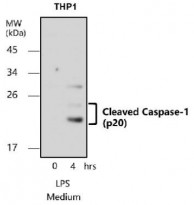ARG41912
anti-Caspase 1 Cleaved Asp297 antibody
anti-Caspase 1 Cleaved Asp297 antibody for Western blot and Human
Pyroptosis Study antibody; NLRP3 Inflammasome Study antibody; NLRC4 Inflammasome Study antibody
Overview
| Product Description | Rabbit Polyclonal antibody recognizes Caspase 1 Cleaved Asp297 |
|---|---|
| Tested Reactivity | Hu |
| Tested Application | WB |
| Host | Rabbit |
| Clonality | Polyclonal |
| Isotype | IgG |
| Target Name | Caspase 1 Cleaved Asp297 |
| Conjugation | Un-conjugated |
| Alternate Names | Caspase-1; Interleukin-1 beta-converting enzyme; IL-1 beta-converting enzyme; CASP-1; ICE; IL-1BC; Interleukin-1 beta convertase; P45; IL1BC; p45; EC 3.4.22.36 |
Application Instructions
| Application Suggestion |
|
||||
|---|---|---|---|---|---|
| Application Note | * The dilutions indicate recommended starting dilutions and the optimal dilutions or concentrations should be determined by the scientist. | ||||
| Observed Size | ~ 21 kDa (cleaved) |
Properties
| Form | Liquid |
|---|---|
| Purification | Affinity purified. |
| Buffer | 100 mM Tris Glycine (pH 7.0), 0.025% ProClin 300, 20% Glycerol and 1% BSA. |
| Preservative | 0.025% ProClin 300 |
| Stabilizer | 20% Glycerol and 1% BSA |
| Concentration | 0.9399999999999999 mg/ml |
| Storage Instruction | For continuous use, store undiluted antibody at 2-8°C for up to a week. For long-term storage, aliquot and store at -20°C. Storage in frost free freezers is not recommended. Avoid repeated freeze/thaw cycles. Suggest spin the vial prior to opening. The antibody solution should be gently mixed before use. |
| Note | For laboratory research only, not for drug, diagnostic or other use. |
Bioinformation
| Database Links | |
|---|---|
| Gene Symbol | CASP1 |
| Gene Full Name | caspase 1, apoptosis-related cysteine peptidase |
| Background | Caspase 1 is a member of the cysteine-aspartic acid protease (caspase) family. Sequential activation of caspases plays a central role in the execution-phase of cell apoptosis. Caspases exist as inactive proenzymes which undergo proteolytic processing at conserved aspartic residues to produce 2 subunits, large and small, that dimerize to form the active enzyme. This gene was identified by its ability to proteolytically cleave and activate the inactive precursor of interleukin-1, a cytokine involved in the processes such as inflammation, septic shock, and wound healing. This gene has been shown to induce cell apoptosis and may function in various developmental stages. Studies of a similar gene in mouse suggest a role in the pathogenesis of Huntington disease. Alternative splicing results in transcript variants encoding distinct isoforms. [provided by RefSeq, Mar 2012] |
| Function | Caspase 1: Thiol protease that cleaves IL-1 beta between an Asp and an Ala, releasing the mature cytokine which is involved in a variety of inflammatory processes. Important for defense against pathogens. Cleaves and activates sterol regulatory element binding proteins (SREBPs). Can also promote apoptosis. Upon inflammasome activation, during DNA virus infection but not RNA virus challenge, controls antiviral immunity through the cleavage of CGAS, rendering it inactive (PubMed:28314590). In apoptotic cells, cleaves SPHK2 which is released from cells and remains enzymatically active extracellularly (PubMed:20197547). [UniProt] |
| Cellular Localization | Cytoplasm. [UniProt] |
| Highlight | Related products: Caspase 1 antibodies; Caspase 1 ELISA Kits; Caspase 1 Duos / Panels; Anti-Rabbit IgG secondary antibodies; Related news: Exploring Antiviral Immune Response RIP1 activation and pathogenesis of NASH |
| Research Area | Pyroptosis Study antibody; NLRP3 Inflammasome Study antibody; NLRC4 Inflammasome Study antibody |
| Calculated MW | 45 kDa |
| PTM | The two subunits are derived from the precursor sequence by an autocatalytic mechanism. [UniProt] |
Images (1) Click the Picture to Zoom In






